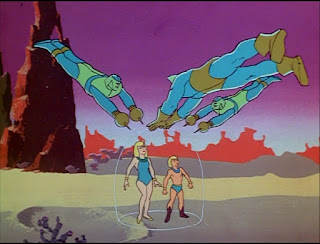Dorno is the son of Zandor, leader of the Herculoids, and his wife Tara, a family of three humans and their five very powerful pet creatures defending their jungle planet. The Herculoids were the subjects of an American animated television series, which debuted in 1967 and was revived in 1981 on CBS and produced by Hanna-Barbera Productions.
Dorno has a cute, boyish face, long, blond hair, and a slender, athletic physique. His shirtless Herculoids outfit consists of a pair of brown boots, a light, blue skirt and neck collar, and a gold belt and wrist bands. At his age, he is growing taller and more attractive and gaining better muscle definition and athletic ability. He is also developing more self-esteem and self-confidence and taking more risks.
Due to his youth and his lack of special powers, Dorno is certainly one of the most vulnerable members of the Herculoids and is frequently a weak link which their opponents seek to target.
In this episode, an army of giant ants threaten to destroy all life in its path. A crumbling ledge puts Tara in their path. She is rescued by Dorno, Tundro, Gloop, and Gleep.
Dorno's best scene is atop Tundro with Gloop and Gleep.
Favorite shot:
Next blog: Dorno in Swamp Monster (11/18/1967)
https://www.amazon.com/Herculoids-Complete-2-Disc/dp/B00553KAK2/ref=sr_1_2?crid=A864MLT2E86B&dchild=1&keywords=herculoids+cartoon&qid=1612274032&sprefix=herculoids%2Cinstant-video%2C187&sr=8-2













































